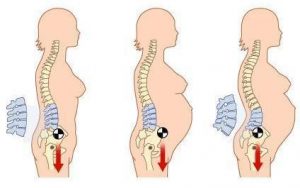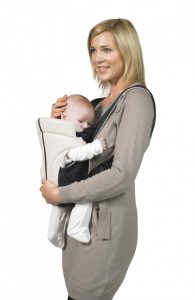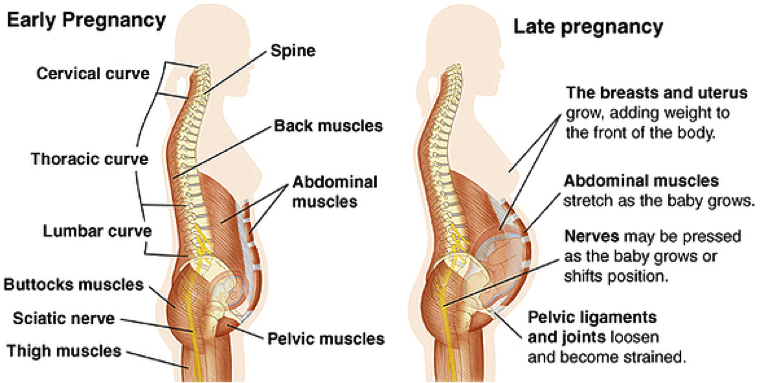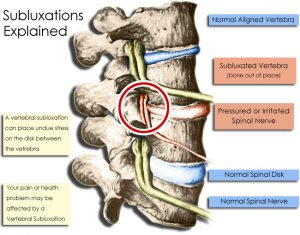At complete chiropractic back pain is probably the most common problem we work with. There are may sources of back pain, but a common (and avoidable) theme for many of our female clients is the stress and strain of being a new mum. Many women look back at the birth of their child as the happiest moment of their lives – but also as the point where their back pain started! Today we stress that back pain need not be a part of being a new mum – and there’s a great deal you can do to avoid and treat it.
Being a mum is hard work – especially a new mum. Between nappy changes, feeding time and lack of sleep, its easy for mums to neglect their own wellbeing – However, in order to give her best to baby, mom must also be at her best, both right now and in the future. An often overlooked but critical issue to consider is maintaining a healthy spine. We’re not just talking about the immediate aches and pains surrounding pregnancy itself – research shows that physiological changes caused by pregnancy combined with the physical demands of childcare leave 16 percent of postpartum women with persistent lower back pain[1] – even more commonly seen is a spinal condition known as vertebral subluxation, which can cause problems further down the road. Subluxation This occurs when spinal bones (vertebrae) become restricted or slightly misaligned.
Vertebral solutions may not initially cause pain (or often, it might not start out seeming particularly significant) but if left unchecked it can begin to interfere with nervous system activity, in turn leading to a plethora of health problems ranging from back pain and headache to digestive problems and fatigue. Thankfully, at complete chiropractic we specialise in correcting subluxations and successfully treat literally hundreds of cases of lower back pain each year.
How pregnancy affects the spine

As pregnancy progresses, increasing strain is placed upon the spine.
Back pain is a common complaint during pregnancy, especially during the third trimester – and if you’re a mum you almost certainly already know that! However, what you may not realise is that some of the factors which can cause discomfort during pregnancy can continue to impact a woman long after your baby is born. More than just adding weight for the spine to manage the growing baby and uterus actually change the mother’s centre of gravity- which in turn puts a high load on the spine and pelvis[2]. Additionally, Abdominal muscles stretch and lose tone so they are less able to help the spine maintain a neutral posture, as they normally would[3].
As with many pregnancy woes, hormones also play a role in the development of vertebral subluxations. A pregnant woman ‘s body releases ten times the normal amount of the hormone relaxin during the first trimester. Relaxin’s job is to loosen the joints and ligaments in the pelvis to make room for the growing uterus, and to allow for delivery – this is helpful! However, relaxin also loosens ligaments in the spine – which is not so helpful! The extra weight of the uterus compresses these loose l ligaments, often producing vertebral subluxations and related low back pain. Reearch indicates that these ligaments stay loose and prone to overstretching for up to eight months following birth, which may account for the many women who report problems which occur or worsen after birth[4].
How Chiropractic Care can help
When we think about pregnancy, we tend to focus on the changes which occur in the body throughout the pregnancy itself, and the immediate recovery period after birth – however the body goes on re-adjusting long after your baby is born. Over time, swollen tissues shrink back and bones and joints shift back toward their usual positions. Aches and pains – especially in the low back – can accompany these changes and may be compounded in the case of a difficult labor. Combined with the stress of the work which comes with a new baby, its easy to see how spinal problems can develop.
Many mums simply rely on pain medication to alleviate postpartum back pain, and over the short term this might be effective – however taking medication to cover up a problem, rather then addressing the cause is rarely the best approach. In addition studies find that pain killers are often minimally effective and cause a variety of side effects[5]. Perhaps most problematic however, many pain killers may also be unsafe for use breastfeeding mothers, as the drugs can contaminate the breast milk.
By contrast, Chiropractic is a safe and proven form of therapy for back pain and other musculoskeletal complaints both during and after pregnancy, and relies only on totally natural methodologies[6]). If you received chiropractic care during pregnancy , continue to do as your body recovers from childbirth – If you are a new mum and not already receiving chiropractic care, why not get in touch and see how we can help?
Lift your baby safely
An average newborn weighs 7.5 pounds (3.4 kilograms) – which might not seem a lot, but this can add up to a considerable load on the body when you consider that the average baby gets picked up about 50 times each day! Further, babies more than double their weight in the first year, more than making up for less frequent lifting as they become increasingly independently mobile. All of this makes a proper lifting technique a vital skill for mothers – as well as fathers and other caregivers.
The old wisdom to “lift with your knees, not with your back” has persisted because it’s true. The spine best functions in what is called the neutral position. Bending at the waist with straight knees (without lifting anything) actually puts 150 percent of your body weight on the lower back. Picking up a baby or other load from this already precarious pose often causes the back to round – a position that places enormous stress on the spine. Muscle strain or spasm, overextended ligaments and stress on the bones may ensue.
To lift your child safely, keep the back in the neutral position and squat or kneel on one knee. Allow the pelvis to rotate as needed, but take care not to round your back. Grasp baby on both sides of his or her torso so that both arms will take equal weight. Hold the child cantered in front of your body and close to your centre of gravity – near your belly button.
Use your leg muscles to complete the lift, and keep the abdominal muscles tight to support your back. Avoid twisting your spine -this is a common cause of back injury when moving a baby or child in or out of a car seat[7]. Protect your back by kneeling on the seat next to the car seat while assisting your child.
All that being said, as a parent its simply impractical to lift perfectly every time, and that’s where chiropractic care can pick up the slack. Having chiropractic care doesn’t exempt you from the need for safe lifting – but it certainly does help the body cope with the worst of the work!
Choose an Ergonomic Baby Carrier
Today “baby carriers” (as opposed to prams) are all the rage – and with good reason, research as well as anecdotal evidence suggests that a baby carrier promotes emotional and psychological development of your baby, as well as providing a more reassuring experience for both parent and child. We’re all in favor of baby carriers, but do consider your spine when choosing one!
Generally speaking, we prefer backpack-style front carriers, which ideally should have wide straps to distribute your child’s weight evenly and comfortably across your shoulders and waist. Some research shows that carrying weight (such as a baby) on the front of the body is preferable for maintaining good posture[8]. It’s very important that the carrier be adjusted so as to fit you properly, especially if you are wearing it for long periods – ensure that all straps are snug as loose straps do no distribute the weight as intended. You might also want to consider the ease of adjustment of the carrier – if quick and effective adjustment of the straps is not possible, consider purchasing and setting up a carrier for each would be baby-carrier.
Side carriers on the other hand, can harm the back as the free shoulder tries to counterbalance the weighted shoulder, curving the spine. If you must use a side carrier, alternate sides frequently to minimize risk of back and neck injury.
Watch Your Breastfeeding Position
Breastfeeding is another childcare activity in which attention to body mechanics can prevent vertebral subluxations. Sit up with the spine in neutral position, using cushions as needed to support your back . Be sure to bring the baby to your breast rather than leaning over the baby – this rounds and strains the spine.
Use pillows in your lap to support your arms and baby. Many specialty pillows are available specifically for this purpose. Support your lower back by placing your feet flat on a stool or foot rest. As an alternative you may also find it comfortable (and less tiring!) to nurse lying on your side, using pillows to support the back and knees.
It is not unusual to need assistance establishing a breastfeeding routine- for problems getting baby started, consult a GP or Midwife without delay, but for issues of posture or if you notice back pain developing, give us a call before back pain gets in the way of your feeding routine.
Exercise for a Strong Back
Exercise is a critical component of any spinal care plan – regular strengthening and postural exercises help to promote spinal health and correct imbalances which can cause problems down the line.
The road back to normal function after pregnancy si different for everyone – some return to physical activity very quickly, while others feel the need a little longer. As a general principle, light exercise should be resumed as soon as your midwife or obstetrician suggests, and gradually stepped up to pre-pregnancy levels[9] .
Meanwhile, strengthening and toning exercises, of the kind we provide at complete chiropractic can help to begin rebuilding flexibility and muscle tone with just a few simple routines each day. Even a small amount of targeted exercise will help your body handle the new demands of caring for your baby. More broadly, developing strength in abdominal and back muscles reduces postpartum back pain[10], strengthening your arms can stave off soreness caused by constantly picking up your child. What’s more, routine exercise may prevent postpartum depression[11]. In all cases, chiropractic care can assist in helping you to optimise your exercise and recovery.
Mind Your Posture
Finally, and perhaps most simply of all, try to remain conscious of your posture. The spine-compressing ··sway back” posture of the last months of pregnancy can be a difficult habit to kick after delivery – but over time this habit can lead to all kinds of back problems. Whether sitting, standing, or walking, imagine being suspended by a string from the top of your head. This lengthens the spine and engages abdominal and pelvic floor muscles to support the back. Using these stabilizing muscles to maintain good posture reduces back pain[12] and prevents injury.
If you have any concerns or questions about your posture (most people do!) just ask at your next appointment, or get in touch today!

[1] Spine 2008;20:386-93
[2] Obstet Gyneco/ Surv 2008;63: I 03- 1 I
[3] Mecisc Worn Health 1997;2:2
[4] J Women’s Health 2009 ;18:663-5
[5] Expert Opin Pharmacother 2004 ; 5:2091-8
[6] J Chiropr Med 2007 ;6 :70-4 ; J Midwifery Women ‘s Health 2006 ;51 :e7-IO
[7] Contemporary Ergonomics 2002
[8] Ergonomics 2006;49:885-94
[9] Br J Sports Med 2003;37:6-12
[10] Physiother Res Int 2008; 13:18-30
[11] Phys Ther 2010;90:348-55
[12] Spine 2006;31 :E707-12


